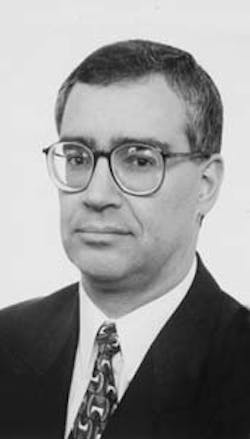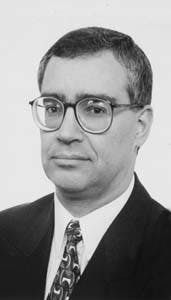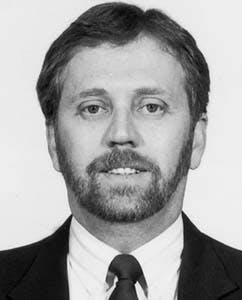CAUSTIC-FREE JET FUEL MEROX UNIT REDUCES WASTE DISPOSAL
Paul R. Cressman, Maureen L. Hurren
Petro-Canada Products
Oakville, Ont.Edward F. Smith, David L. Holbrook
UOP
Des Plaines, Ill.
For Petro-Canada Inc.'s refinery in Oakville, Ont., near Toronto, the handling and disposal of spent caustic streams was not only an environmentally sensitive issue, but also a continuous and escalating expense.
To overcome these problems, the company converted its caustic-based UOP jet fuel Merox unit to a Caustic-Free Merox design.
The Caustic-Free unit reduced the quantity of spent caustic generated at the Oakville plant by one half. The resulting savings for the refinery are $190,000-$210,000(U.S.)/year.
TRIAL RUNS
UOP undertook a 3-year catalyst research program to develop the Caustic-Free Merox process, which uses ammonia instead of sodium hydroxide as its alkaline source. Once the viability of the process was established in pilot plants, Petro-Canada was asked to carry out a full-scale trial run in its UOP jet fuel Merox unit.
By 1990, Caustic-Free operation on gasoline had been commercially demonstrated in a unit that had been revamped from a UOP Minalk design to sweeten fluid catalytic cracking (FCC) unit gasoline. This unit has operated successfully in Caustic-Free mode since the revamp.
A jet fuel application, however, presents many more uncertainties, with respect to commercial operation, because of the unique and stringent product specifications for jet fuel. Additionally, kerosine is more difficult to sweeten than FCC gasoline because of the types of mercaptans present.
After Petro-Canada agreed to participate in a 90-day trial run, a multifunctional team was formed. The team included personnel from the refinery's operations, laboratory, maintenance, project, and process engineering groups. In conjunction with UOP engineers, the team designed and installed the required modifications and conducted the test run.
The first commercial trial run treating jet fuel began in October 1992. The trial was halted in January 1993 because of problems with an ammonia odor in the treated product.
Working with UOP, Petro-Canada designed and installed modifications to eliminate the ammonia odor problem. The modifications involved improving the water-washing efficiency in the post-treatment section of the unit to remove residual ammonia and ensure an odor-free product.
The trial resumed in May 1993. Following two months of odor-free operation, the trial was declared a success. On July 31, 1993, Petro-Canada notified UOP of its commercial acceptance of the Caustic-Free Merox process for treating jet fuel.
THE DECISION
Prior to 1992, Petro-Canada's Oakville refinery used caustic soda solutions of varying strengths in its Merox unit. A number of UOP Merox sweetening and extraction units were in service at the time. These units reduce odor and remove sulfur from a variety of product streams.
Before the revamp, the Oakville refinery consumed large quantities of caustic because of its two parallel crude trains, two fluid catalytic cracking units - each with its own caustic-based treating units-and the jet fuel Merox unit.
Between 1989 and 1992, the disposal of spent caustic had become a costly environmental problem. Because the refinery lacked a caustic neutralization and treatment unit, internal disposal options were limited. And only minimal volumes of spent caustic could be injected into the crude units to control corrosion in the crude tower overheads without causing excessive fouling of the crude preheat exchanger trains or coking of the heater tubes.
Spent caustic processing through the refinery's wastewater treatment plant also was severely limited as a result of stringent regulatory limits on the quality of water discharged into nearby Lake Ontario. At the same time, the availability of external disposal options was declining.
Prior to 1990, large quantities of spent sulfidic caustic were shipped to pulp and paper mills for reuse in that industry's production process. The expanded recycling of paper eventually reduced caustic demand for paper processing.
An additional problem created by the strong odor of sulfidic caustic, and the resultant occupational concerns of millworkers, later eliminated this disposal route as an option. Likewise, the acid-oil content of the spent caustic was not sufficient to allow the economic recovery of phenols and cresols by companies that specialize in this work.
Hiring environmental waste management companies licensed to handle refinery spent caustic was quite expensive. Disposal costs, including transportation, typically were about $2(U.S.)/gal(U.S.) of spent caustic. One disposal option based on incineration technology cost more than $4/gal.
By early 1992, the volume of caustic requiring external disposal was averaging 160,000 gal/year, at an average annual cost of $330,000.
Petro-Canada had investigated the possibility of installing a caustic neutralization and treatment unit, which would have allowed all spent sulfidic caustic to be disposed of internally and safely. But even the high cost of external disposal options was not sufficient to justify the capital expenditure anticipated for the neutralization and treatment facilities.
Ultimately, Petro-Canada determined the conversion of the jet fuel Merox unit to a Caustic-Free system to be the most cost-effective means of reducing spent caustic disposal costs.
PROCESS DESCRIPTION
The name Merox is derived from the term "mercaptan oxidation." A conventional-style sweetening unit is composed of three distinct sections (Fig. 1) (83036 bytes):
- Pretreatment - This section contains a package coalescer, which removes the condensed water that comes from steam stripping upstream, and a caustic prewash vessel, which removes naphthenic acids. Free water is removed to minimize the dilution of low-strength caustic in the downstream prewash vessel. Naphthenic acids are removed in the prewash vessel to eliminate reaction with high-strength caustic in the downstream reactor section. If these acids are not removed, the resultant sodium naphthenate salts foul and deactivate the catalyst bed because of their strong surfactant and soap-like nature.
- Reaction - This section includes a vertical, fixed-bed reactor and a horizontal caustic settler. The oxidation (sweetening) of mercaptan sulfur compounds to disulfides takes place in the reactor in the presence of Merox catalyst, air, and caustic soda according to the equation: 4RSH + O2 - 2RSSR + 2H2O. The separation of hydrocarbon and caustic, which occurs in the settler, allows intermittent caustic recycle back to the reactor.
- Post-treatment-This section includes a water-wash vessel, a salt filter (dryer), and a clay filter. Post-treatment is designed to remove residual water, oil-soluble surfactants, and any organometallic compounds that would otherwise affect the stringent jet fuel specifications.
Petro-Canada's conventional caustic-based UOP Merox unit was commissioned in 1983 to treat 7,500 b/sd of jet fuel. Because the process principles of the caustic-based and Caustic-Free versions of the Merox process are essentially the same, the flow schemes are similar. The conversion to Caustic-Free technology therefore was relatively simple (Fig. 2). (63970 bytes)
Several differences, however, distinguish Caustic-Free operation:
- A prewash vessel is no longer required because the reaction between ammonia and naphthenic acid is not detrimental. Because ammonium naphthenates are highly soluble in water, they do not have the emulsive tendencies that sodium naphthenates have. Thus, a major source of waste caustic is removed from the jet fuel treating unit.
- The reactor and settler remain in place after revamping to the Caustic-Free mode. However, the reactor is loaded with a specially prepared, preimpregnated catalyst (UOP Merox No. 31). Although the caustic-based catalyst system requires a strong alkaline environment to drive the oxidation reaction forward, the high activity provided by the Merox No. 31 catalyst allows the use of a weaker base, such as ammonia.
- A liquid catalyst activator (Merox CF) is continuously injected into the reactor feed to provide long-term catalyst stability. To eliminate the handling of disposable drums, Petro-Canada chose to use the UOP cycle-drum system, a returnable drum system for supplying liquid products. Water and ammonia also are added separately to the feed to provide the aqueous and alkaline environment that the process requires. Although Petro-Canada chose to inject aqueous ammonia, anhydrous ammonia also can be used.
- The settler immediately downstream of the reactor is a holding vessel that allows the hydrocarbon and the aqueous ammonia to separate. The jet fuel exits the top of the settler and goes to the water-wash vessel. Petro-Canada piped the ammonia/water effluent line from the bottom of the vessel directly to their refinery sour-water stripper, where the ammonium naphthenates thermally decompose to ammonia and naphthenic acid. Alternatively, the reactor settler effluent can be sent to a small, dedicated ammonia stripper. Using this option, ammonia is recovered and recycled back to the reactor.
- The water wash, salt filter, and clay filter remain intact for Caustic-Free service to meet jet fuel specifications. The water-wash vessel, however, is converted from a batch style to a multistage contacting vessel to remove residual ammonia and to maximize clay life in the downstream filter. For new and revamp units, a high-efficienCY, proprietary structured packing is currently specified for the water-wash vessel, which is then integrated into a two-stage wash system.
MODIFICATIONS
The changes to the configuration of the Oakville unit after the revamp to Caustic-Free technology are illustrated in Fig. 2. (63970 bytes) These changes included:
- Chemical injection pumps and piping for adding Merox CF activator, aqueous ammonia, and water to the reactor feed
- Piping from the bottom of the reactor settler (formerly the caustic settler) to the refinery sour-water system
- Piping modifications to integrate the idle caustic prewash vessel into a three-stage water-wash system
- Modifications to the existing low-capacity pumps for use as water-transfer pumps within the three-stage water-wash system.
The total investment in mechanical equipment required to retrofit the jet fuel Merox unit to a Caustic-Free Merox unit was $120,000, including piping (50% of cost), pumps (20% of cost), insulation, instrumentation, electrical work, control valves, and design engineering.
In addition, Petro-Canada replaced the fixed-bed catalyst. A change in catalyst was considered part of the scheduled change-out rather than an incremental capital investment.
For comparison, Fig. 3 (60647 bytes) shows an alternative way to revamp an existing jet fuel Merox unit to the Caustic-Free mode.
OPERATIONS
Table 1 (16430 bytes) and Table 2 (10652 bytes) list Petro-Canada's typical feedstock and product properties and unit operating conditions. Although the acid number and mercaptan sulfur content of the kerosine feed have remained fairly steady, the endpoint was intentionally increased during certain periods to produce stove oil.
Higher-endpoint materials generally contain mercaptans that are more difficult to convert. Minor adjustments in operating conditions, such as injection rates of air, ammonia, and Merox CF additive, have always brought the mercaptan level of the jet fuel product well below the 30 ppm[wt] specification.
During 1994, the average mercaptan sulfur content of the incoming feed was 93 ppm[wt]. The corresponding average mercaptan-sulfur content in the product was 8 ppm[wt]. This experience confirmed to Petro-Canada that the Merox Caustic-Free catalyst system is inherently more active than the previous caustic operation.
Based on UOP's development work, an ammonia injection rate of 40 ppm[wt], based on feed, was targeted to maintain the alkaline environment. Nevertheless, Petro-Canada is having good success injecting as low as 20 ppm[wt] ammonia.
Not only does this injection rate reduce ammonia consumption, it also helps reduce the residual ammonia in the water-washed jet fuel to less than 0.5 ppm[wt] of ammonia entering the downstream clay filter. In the long run, clay life is extended by minimizing the cumulative quantity of ammonia injected into the unit.
ECONOMICS
The Petro-Canada caustic-based Merox operation had a combined operating and spent caustic disposal cost totaling $0.139/bbl of unit charge. This amount includes chemicals (caustic, rock salt, Attapulgas clay), utilities, and spent caustic disposal.
At $2/gal, the disposal of spent caustic accounted for more than 90% of the total operating cost.
In comparison, the current cost of Caustic-Free operation is $0.067/bbl of unit charge, a reduction of 52%. This amount includes chemicals (Merox CF additive, aqueous ammonia, treated water, rock salt, Attapulgas clay), utilities, and ammonia-water effluent treating.
Although the economic benefits achieved through the elimination of caustic usage and disposal are partially offset by the required addition of Merox CF activator and aqueous ammonia, Petro-Canada is realizing an annual net savings of $190,000-$210,000.
Treating costs for processing about 2 gpm of ammonia-water effluent are negligible. The stream is routed to an 80 gpm sour-water stripper, which processes sour waters from other areas of the refinery. There have been no detrimental effects on stripped-water quality or the operation of the refinery wastewater treatment plant.
BENEFITS SUMMARY
The UOP Caustic-Free Merox process has proven successful in sweetening jet fuel. Petro-Canada's unit continues to meet product specifications for mercaptan sulfur, naphthenic acid, and ammonia.
With the water-wash system enhancements, the unit is capable of limiting ammonia levels in the jet fuel entering the clay filter to less than 0.5 ppm[wt]. The ammonia content of the finished jet fuel is less than 0.1 ppm[wt].
The process also has demonstrated its ability to handle feedstocks of varying quality. The maximum content of mercaptan sulfur has been 150 ppm[wt]. And acid number content has been as high as 0.03 mg KOH/g.
Unit performance, in terms of mercaptan conversion, is being maintained at ammonia injection levels below the original target of 40 ppm[wt].
When caustic was eliminated from the unit, problems associated with sodium naphthenate formation were solved. Previously, hot water washing was performed periodically to remove these surfactants from the catalyst bed to restore activity. The naphthenate salts in the resultant hot-water-wash effluent caused operating problems in the refinery sour-water stripper. Since the conversion, however, this problem has been eliminated.
Caustic-Free operation has reduced spent caustic generation at the Oakville refinery by about 50%. Elimination of this hazardous waste has even more strategic importance in view of ever-tightening regulations governing the disposal of environmental wastes.
In combination with other refinery caustic-management initiatives, this reduction has enabled Petro-Canada to eliminate external disposal of spent caustic.
Conversion of the Oakville refinery caustic-based jet fuel Merox unit to a Caustic-Free Merox unit, and the associated elimination of spent caustic generation from this source, has earned Petro-Canada an environmental award from the Ontario Ministry of Environment and Energy. The award was granted under the ministry's Pollution Prevention Pledge Program, a voluntary program designed to encourage and challenge the industry to adopt pollution control strategies that go beyond regulatory requirements as part of a company's overall goals.
Initiated in late 1993, the program provides government and public recognition for proactive work in the areas of environmental protection and pollution prevention. Petro-Canada was among the first companies in Ontario to receive this award.
THE AUTHORS
Copyright 1995 Oil & Gas Journal. All Rights Reserved.




